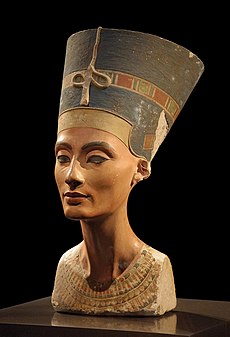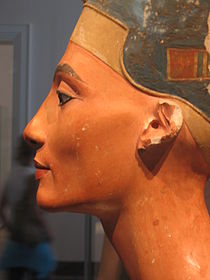Nefertiti Bust

The iconic bust of Nefertiti is part of the Egyptian Museum of Berlin collection, currently on display in the Neues Museum.
|
|
| Material | limestone and stucco |
|---|---|
| Size | Height: 48 centimetres (19 in) |
| Created | 1345 BC: by Thutmose, ancient Egypt |
| Discovered | 1912: Amarna, Egypt |
| Present location | Neues Museum, Berlin, Germany |
 |
|
|
|
The Nefertiti Bust is a painted stucco-coated limestone bust of Nefertiti, the Great Royal Wife of the Egyptian Pharaoh Akhenaten. The work is believed to have been crafted in 1345 B.C. by the sculptor Thutmose, because it was found in his workshop in Amarna, Egypt. It is one of the most copied works of ancient Egypt. Owing to the work, Nefertiti has become one of the most famous women of the ancient world, and an icon of feminine beauty.
A German archaeological team led by Ludwig Borchardt discovered the bust in 1912 in Thutmose's workshop. It has been kept at various locations in Germany since its discovery, including the cellar of a bank, a salt mine in Merkers-Kieselbach, the Dahlem museum, the Egyptian Museum in Charlottenburg and the Altes Museum. It is currently on display at the Neues Museum in Berlin, where it was originally displayed before World War II.
The Nefertiti bust has become a cultural symbol of Berlin as well as ancient Egypt. Nefertiti herself has become quite an icon. Nefertiti is widely known for her beauty and versatility. It has also been the subject of an intense argument between Egypt and Germany over Egyptian demands for its repatriation. It was dragged into controversy by the Body of Nefertiti art exhibition and also by doubts over its authenticity. However various testing and analysis of the bust have proved it to be authentic.
Nefertiti (meaning "the beautiful one has cometh forth") was the 14th-century BC Great Royal Wife (chief consort) of the Egyptian Pharaoh Akhenaten of the Eighteenth dynasty of Egypt. Akhenaten initiated a new monotheistic form of worship called Atenism dedicated to the Sun disc Aten. Little is known about Nefertiti. Theories suggest she could have been an Egyptian royal by birth, a foreign princess or the daughter of a high government official named Ay, who became pharaoh after Tutankhamun. She may have been the co-regent of Egypt with Akhenaten, who ruled from 1352 BC to 1336 BC. Nefertiti bore six daughters to Akhenaten, one of whom, Ankhesenpaaten (renamed Ankhesenamun after the suppression of the Aten cult), married Tutankhamun, Nefertiti's stepson. Nefertiti was thought to have disappeared from history in the twelfth year of Akhenaten's reign, though whether this is due to her death or because she took a new name is not known. She may also have later become a pharaoh in her own right, ruling alone for a short time after her husband's death. However, it is now known that she was still alive in the sixteenth year of her husband's reign from a limestone quarry inscription found at Dayr Abū Ḥinnis. Dayr Abū Ḥinnis is located "on the eastern side of the Nile, about ten kilometres north of Amarna."
...
Wikipedia
